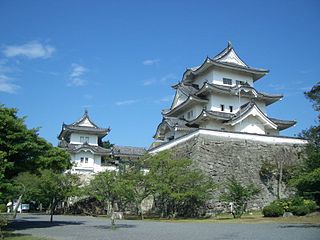 W
WAnorisaki Lighthouse is a lighthouse on the top of Shima Peninsula in the city of Shima, Mie Prefecture, Japan.
 W
WIga Ueno Castle , also known as Ueno Castle is a Japanese castle located in the city of Iga, Mie Prefecture in the Kansai region of Japan. The castle is also called Hakuho Castle , or "White Phoenix Castle," because of its beautiful architecture and floor plan. The castle has been protected by the central government as a National Historic Site since 1967.
 W
WThe Ninja Museum of Igaryu situated in a forested location in Iga, Mie Prefecture, Japan, is a museum dedicated to the history of the ninja and ninjutsu. It was established in 1964 and is located near Iga Ueno Castle. Jinichi Kawakami, who serves as the honorary director of the Iga-ryū Ninja Museum, is proclaimed to be the 21st head of Iga-ryū ninjutsu.
 W
WJapon Louvre Sculpture Museum opened in Tsu, Mie Prefecture, Japan in 1987. The collection comprises some 1,300 replicas of famous statues from the Louvre—as agreed with then director Hubert Landais—and other collections, and includes those of the Venus de Milo, Winged Victory of Samothrace, Apollo Belvedere, Townley Discobolus, and Bust of Nefertiti, as well as of Michelangelo's Moses. The museum is managed and operated by the local Shingon temple of Daikannon-ji (大観音寺), which was established in 1982.
 W
WMatsuura Takeshirō Memorial Museum opened in Matsusaka, Mie Prefecture, Japan in 1994. It is dedicated to the life and work of local scion and explorer Matsuura Takeshirō, who travelled to Ezo six times at the end of the Edo period, penning many volumes of diaries and producing many maps. The collection includes the Important Cultural Property Materials Relating to Matsuura Takeshirō, an assemblage of some 1,503 items.
 W
WMie Prefectural Art Museum opened in Tsu, Mie Prefecture, Japan, in 1982. The collection has a particular emphasis on yōga.
 W
WMie Prefectural Museum opened on a new site in Tsu, Mie Prefecture, Japan, in 2014. Also known as MieMu, it replaced the former Mie Prefectural Museum which opened in 1953 and closed in 2014.
 W
WMotoori Norinaga was a Japanese scholar of Kokugaku active during the Edo period. He is conventionally ranked as one of the Four Great Men of Kokugaku (nativist) studies.
 W
WThe Natsumi temple ruins is an archaeological site with the ruins of an Asuka to Nara period Buddhist temple located in the Natsumi neighborhood of the city of Nabari, Mie Prefecture Japan. The temple no longer exists, but the temple grounds were designated as a National Historic Site in 1990.
 W
WThe Saikū (斎宮), was a palace complex located in what is now the Takegawa neighborhood of the town of Meiwa, Tai District, Mie Prefecture, Japan. Forming a small village, it was established in the Nara period as the palace and public offices of the Saiō, an unmarried Imperial princess who served at Ise Shrine on behalf of the emperor, and fell into ruins in the Nanboku-chō period. The site was designated a National Historic Site in 1979. The Saikū is also referred to as the "Bamboo Palace", Saigū, Itsuki no Miya, Iwai no Miya or Imimiya
 W
WSekisui Museum is a registered museum in Tsu, Mie Prefecture, Japan. First established as Sekisui Kaikan (石水会館) in 1930, the museum was registered in accordance with the Museum Act in 1975, reorganized as a "public interest incorporated foundation" under its present name in 2010, and in the following year relocated from Marunouchi to Tarumi, reopening in new premises nestled in a wooded area of Mount Chitose in May 2011. The collection includes tea utensils, paintings, books, historical materials relating to the merchants of Ise Province, and items relating to potter and founder Kawakita Handeishi (1878–1963).
 W
WToba Sea-Folk Museum is a museum dedicated to the area's fishing traditions in Toba, Mie Prefecture, Japan. Having first opened as the private Sea-Folk Museum in 1971, the museum reopened in its current location in 1992, and in 2017 was reestablished as a public, municipal museum under its current name. In 1998, the museum buildings, designed by Naitō Hiroshi, were included amongst the 100 Select Instances of Public Architecture by the then Ministry of Construction. The collection, numbering some 61,840 items as of 31 March 2018, includes some ninety wooden boats from all over Japan, the nation's most comprehensive assemblage of materials relating to the Ama, and a grouping of 6,879 pieces of Ise Bay, Shima Peninsula, and Kumano Sea Fishing Equipment that have been jointly designated an Important Tangible Folk Cultural Property. The displays are organized around seven themes: traditions of sea-folk, sea-folk faith and festivals, sea pollution, Ama divers in Shima, fishing in Ise Bay, fishing in Shima and Kumano, and wooden boats and navigation.